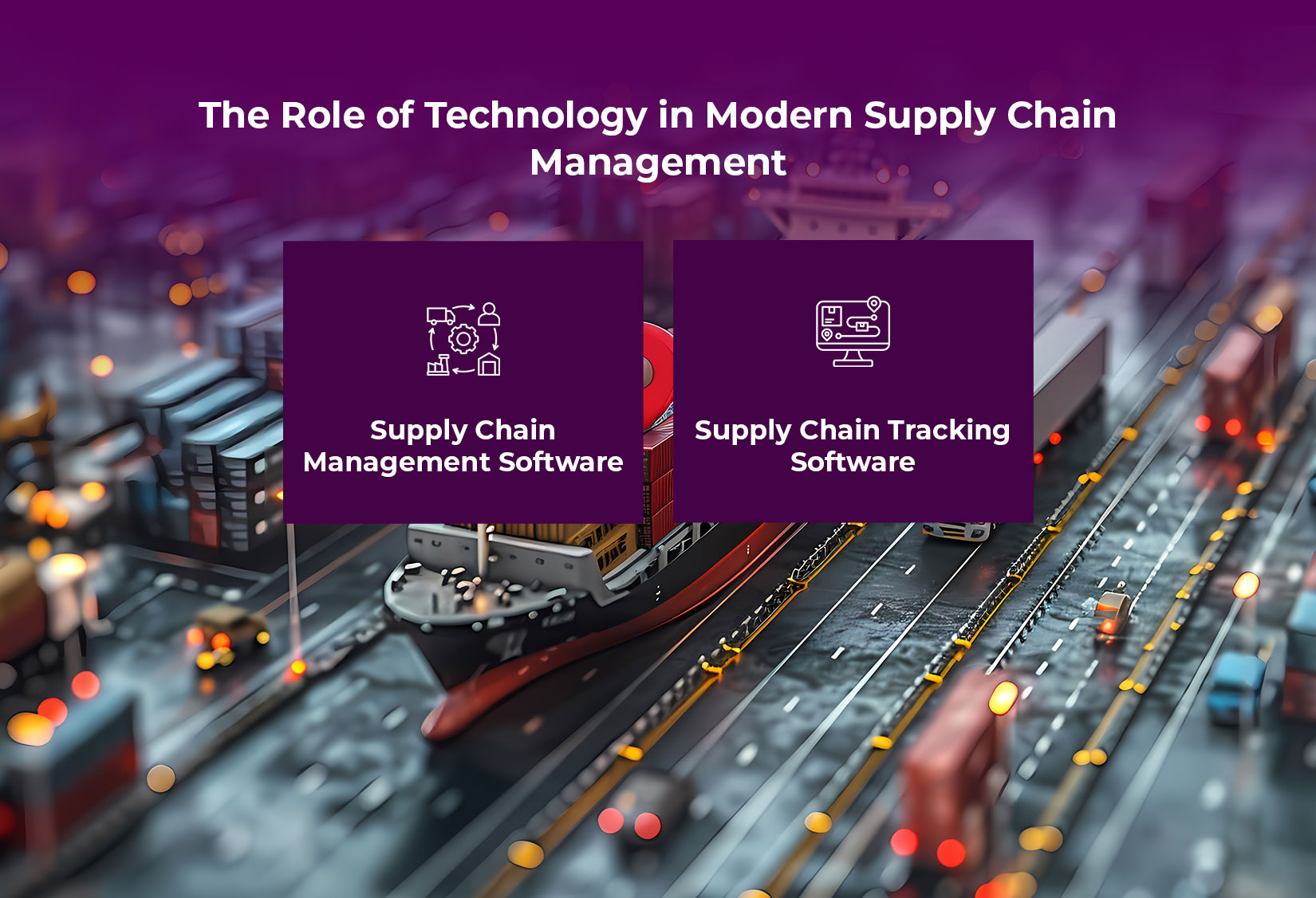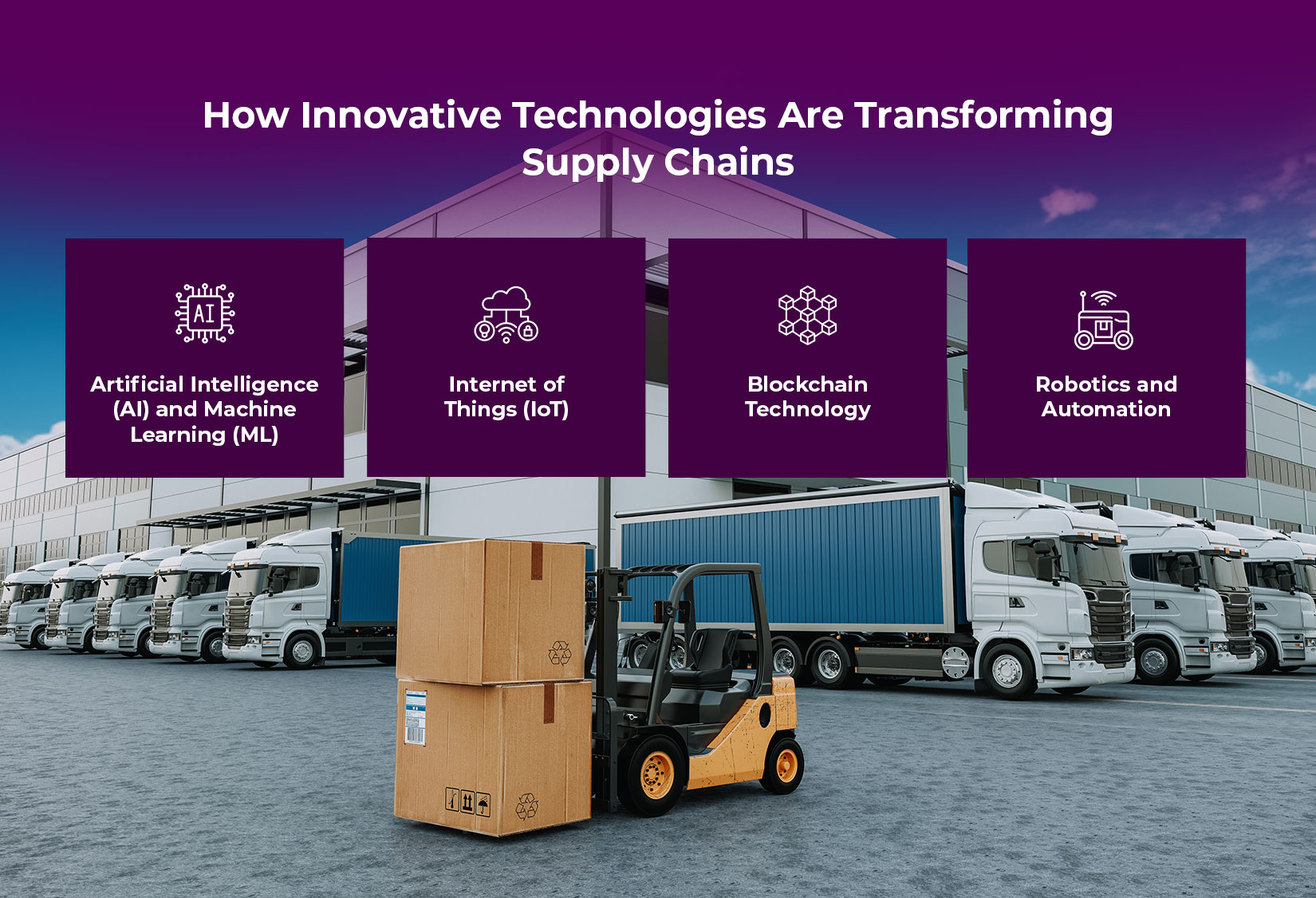In today’s fast-paced world, supply chain management has become more critical than ever. Businesses face growing pressure to streamline operations, reduce costs, and meet increasing customer expectations. Supply chain management using traditional approaches is no longer adequate. To stay competitive, companies must embrace innovative technologies that can transform their logistics processes.
This blog explores how cutting-edge technologies are reshaping supply chains and why implementing advanced supply chain management systems is crucial for business success.
The Role of Technology in Modern Supply Chain Management

Supply chain management involves the coordination of various processes, including procurement, production, transportation and inventory management. With global chains becoming more complex, businesses need efficient solutions to handle these challenges.
1. Supply Chain Management Software:
One of the most significant advancements in modern logistics is the adoption of supply chain management software. These sophisticated tools empower businesses to automate and optimize various supply chain processes, leading to enhanced efficiency and reduced operational costs. By minimizing manual efforts and human errors, companies can achieve greater accuracy and faster processing times.
For instance, supply chain management software enables real-time tracking of inventory levels, helping businesses avoid stockouts or overstocking scenarios that can disrupt operations and lead to financial losses. It facilitates better decision-making by providing actionable insights into procurement needs and inventory replenishment schedules.
A Statista analysis projects that the global supply chain management software market will reach $37.41 billion by 2027. This reflects the growing importance of these tools in modern logistics strategies.
2. Supply Chain Tracking Software:
Supply chain tracking software has revolutionized logistics by providing real-time visibility into the movement of goods across various stages of the supply chain. With these tools, businesses can monitor shipments from origin to destination. This helps ensure that products are delivered on time and in optimal condition.
Real-time tracking improves transparency, allowing businesses to identify potential delays and bottlenecks swiftly. This capability enhances customer satisfaction by providing accurate delivery timelines and reducing uncertainties. According to a study by Deloitte, companies that implemented real-time tracking solutions experienced a 15-20% improvement in delivery times and a 30% reduction in logistics costs.
Such improvements highlight the value of supply chain tracking software in fostering reliable and efficient operations. These capabilities are crucial in today’s fast-paced and customer-centric business environment.
How Innovative Technologies Are Transforming Supply Chains

1. Artificial Intillengence (AI) and Machine Learning (ML):
AI and ML are revolutionizing supply chain management by providing predictive analytics and auto-mating decision making processes. These technologies can analyze historical data to forecast demand, optimize routes and identify potential risks.
AI-powered systems enable companies to anticipate market trends and adapt accordingly. For instance, during peak seasons, ML algorithms can forecast spikes in demand, ensuring that businesses maintain adequate inventory levels. AI also enhances warehouse operations by optimizing layout and improving picking accuracy, reducing order processing time.
According to a report by Gartner, businesses that adopted AI-driven supply chain management saw a 25% reduction in inventory costs and a 35% improvement in order accuracy. Moreover, AI assists in risk management by identifying vulnerabilities in the supply chain. It can predict disruptions caused by natural disasters, geopolitical events or supplier issues, enabling businesses to take proactive measures to mitigate risks.
2. Internet of Things (IoT):
IoT devices are transforming logistics by connecting various components of the supply chain. Smart sensors can monitor the condition of during transit. This can help in ensuring that temperature-sensitive products remain within safe ranges.
IoT technology offers end-to-end visibility, helping businesses track shipments in real-time. For example, logistics companies can use IoT devices to monitor vehicle performance, fuel consumption and route efficiency. According to Cisco, the number of connected to IoT devices in supply chains is expected to reach 50 billion by 2023. This can significantly enhance visibility and operational efficiency.
In warehouses, IoT-enabled smart shelves automatically update stock levels. This reduces manual inventory checks and ensures that replenishment orders are placed promptly. A study by McKinsey found that businesses leveraging IoT in their supply chains saw a 15% reduction in transportation costs. Additionally, they experienced a 20% improvement in asset utilization.
3. Blockchain Technology:
Blockchain technology offers a secure and transparent way to manage supply chain data. It creates a tamper-proof ledger of transactions, making it easier to track the origin and movement of goods.
Blockchain enhances trust among stakeholders by providing a single source of faith. For instance, in the food industry, blockchain can verify the authenticity of products. This ensures that consumers receive safe and genuine items. It also streamlines compliance by maintaining immutable records of regulatory documentation.
According to PwC, blockchain adoption in supply chains can reduce administrative costs by up to 30% and cut fraud risks by 75%. Another study by IBM found that businesses using blockchain in logistics saw a 40% reduction in compliance errors. They also achieved a 50% improvement in traceability.
4. Robotics and Automation:
Robotics and automation are becoming increasingly prevalent in warehouses and distribution centers. Automated systems can handle repetitive tasks such as picking, packing and sorting, freeing up human workers for more complex activities.
Robotics arms and autonomous mobile robots (AMRs) enhance warehouse efficiency by reducing the time required to fulfill orders. AMRs navigate warehouse floors using sensors and maps, avoiding obstacles and ensuring safe operations. By assisting human workers, these robots can increase accuracy and productivity.
According to PwC, the use of robotics in supply chain management can reduce labor costs by up to 20%. Additionally, automation improves order accuracy, ensuring that customers receive the correct products on time, enhancing overall satisfaction.
The Future of Supply Chain Management
As technology continues to grow, the future of supply chain management looks optimistic and bright. Emerging technologies like 5G, autonomous vehicles, and advanced robotics will further enhance logistics operations. Autonomous vehicles can improve last-mile delivery efficiency, reducing delays and costs. Additionally, 5G technology will enable faster and more reliable communication between IoT devices, improving real-time data sharing across supply chains.
Advanced robotics will further streamline warehouse operations by automating complex tasks, increasing productivity and reducing errors. The integration of these technologies will result in more agile, responsive and efficient suppl chains. These supply chains will be better equipped to adapt t0 ever-changing market demands.
In addition, supply chain management is increasingly emphasizing sustainability. To lessen their influence on the environment, businesses are embracing eco-friendly methods more and more. Using technggology to optimize transportation routes and reduce waste can contribute to these sustainability goals.
Also Read: Top 6 Supply Chain Visibility Software Trends to Keep an Eye On
Final Thoughts
Transforming logistics through innovative technologies is no longer optional for businesses. Implementing advanced supply chain management systems can significantly improve efficiency and reduce costs. Using tools like supply chain tracking software also helps enhance customer satisfaction.
To stay ahead of the competition, businesses must invest in the supply chain management software that meets their unique needs. By embracing these technologies, companies can create resilient and agile supply chains that are ready to tackle future challenges.
In a world where supply chain disruptions are becoming more common, technology-driven solutions are they key to ensuring smooth and efficient operations. To avoid such disruptions, click on the red button below and book a demo with LogiNext solutions today!
5






















